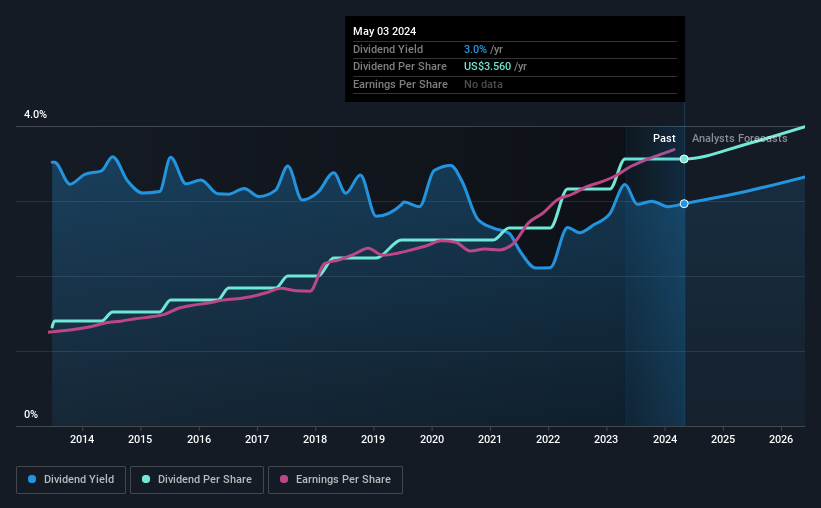Paychex, Inc. (NASDAQ:PAYX) Stock Goes Ex-Dividend In Just Four Days
Paychex, Inc. (NASDAQ:PAYX) stock is about to trade ex-dividend in 4 days. Typically, the ex-dividend date is one business day before the record date which is the date on which a company determines the shareholders eligible to receive a dividend. The ex-dividend date is an important date to be aware of as any purchase of the stock made on or after this date might mean a late settlement that doesn't show on the record date. Accordingly, Paychex investors that purchase the stock on or after the 9th of May will not receive the dividend, which will be paid on the 30th of May.
The company's next dividend payment will be US$0.98 per share. Last year, in total, the company distributed US$3.56 to shareholders. Based on the last year's worth of payments, Paychex stock has a trailing yield of around 3.0% on the current share price of US$120.10. Dividends are a major contributor to investment returns for long term holders, but only if the dividend continues to be paid. So we need to investigate whether Paychex can afford its dividend, and if the dividend could grow.
View our latest analysis for Paychex
Dividends are usually paid out of company profits, so if a company pays out more than it earned then its dividend is usually at greater risk of being cut. Its dividend payout ratio is 77% of profit, which means the company is paying out a majority of its earnings. The relatively limited profit reinvestment could slow the rate of future earnings growth. It could become a concern if earnings started to decline. That said, even highly profitable companies sometimes might not generate enough cash to pay the dividend, which is why we should always check if the dividend is covered by cash flow. It paid out more than half (67%) of its free cash flow in the past year, which is within an average range for most companies.
It's positive to see that Paychex's dividend is covered by both profits and cash flow, since this is generally a sign that the dividend is sustainable, and a lower payout ratio usually suggests a greater margin of safety before the dividend gets cut.
Click here to see the company's payout ratio, plus analyst estimates of its future dividends.
Have Earnings And Dividends Been Growing?
Businesses with strong growth prospects usually make the best dividend payers, because it's easier to grow dividends when earnings per share are improving. If business enters a downturn and the dividend is cut, the company could see its value fall precipitously. For this reason, we're glad to see Paychex's earnings per share have risen 11% per annum over the last five years. It paid out more than three-quarters of its earnings in the last year, even though earnings per share are growing rapidly. We're surprised that management has not elected to reinvest more in the business to accelerate growth further.
Many investors will assess a company's dividend performance by evaluating how much the dividend payments have changed over time. Paychex has delivered 10% dividend growth per year on average over the past 10 years. It's great to see earnings per share growing rapidly over several years, and dividends per share growing right along with it.
The Bottom Line
Is Paychex an attractive dividend stock, or better left on the shelf? Higher earnings per share generally lead to higher dividends from dividend-paying stocks over the long run. However, we'd also note that Paychex is paying out more than half of its earnings and cash flow as profits, which could limit the dividend growth if earnings growth slows. To summarise, Paychex looks okay on this analysis, although it doesn't appear a stand-out opportunity.
Wondering what the future holds for Paychex? See what the 17 analysts we track are forecasting, with this visualisation of its historical and future estimated earnings and cash flow
If you're in the market for strong dividend payers, we recommend checking our selection of top dividend stocks.
Have feedback on this article? Concerned about the content? Get in touch with us directly. Alternatively, email editorial-team (at) simplywallst.com.
This article by Simply Wall St is general in nature. We provide commentary based on historical data and analyst forecasts only using an unbiased methodology and our articles are not intended to be financial advice. It does not constitute a recommendation to buy or sell any stock, and does not take account of your objectives, or your financial situation. We aim to bring you long-term focused analysis driven by fundamental data. Note that our analysis may not factor in the latest price-sensitive company announcements or qualitative material. Simply Wall St has no position in any stocks mentioned.

 Yahoo Finance
Yahoo Finance 
